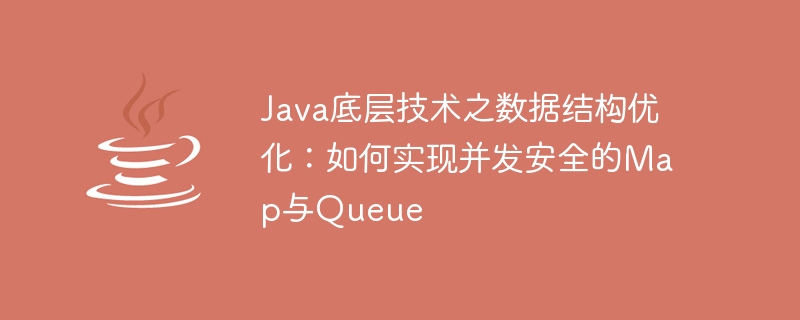

Due to space limitations, I will write an article for you about the data structure optimization of Java's underlying technology, titled "Data structure optimization of Java's underlying technology: Implementing concurrency-safe Map with Queue".
As a high-level language widely used in the field of programming, Java language has attracted much attention for the optimization and concurrency security of its underlying data structure. This article will explore how to implement concurrency-safe Map and Queue in Java and provide specific code examples.
Map in Java is a data structure used to store key-value pairs, while Queue is a first-in, first-out data structure. These two data structures are widely used in actual software development, so their concurrency safety is particularly important.
In order to implement concurrent and safe Map and Queue, we can use the concurrent data structures provided by Java, such as ConcurrentHashMap and ConcurrentLinkedQueue. These data structures can provide better performance and security in multi-threaded environments.
First, let’s take a look at how to implement a concurrently safe Map. The following is a simple sample code:
import java.util.Map;
import java.util.concurrent.ConcurrentHashMap;
public class ConcurrentMapExample {
public static void main(String[] args) {
Map<String, String> concurrentMap = new ConcurrentHashMap<>();
concurrentMap.put("key1", "value1");
concurrentMap.put("key2", "value2");
System.out.println(concurrentMap.get("key1"));
}
}In the above example, we used ConcurrentHashMap to implement a concurrency-safe Map. In a multi-threaded environment, ConcurrentHashMap can provide better performance and concurrency safety. Therefore, when we need to use Map in a multi-threaded environment, it is recommended to use ConcurrentHashMap to ensure data security.
Next, let’s take a look at how to implement a concurrency-safe Queue. The following is a simple sample code:
import java.util.Queue;
import java.util.concurrent.ConcurrentLinkedQueue;
public class ConcurrentQueueExample {
public static void main(String[] args) {
Queue<String> concurrentQueue = new ConcurrentLinkedQueue<>();
concurrentQueue.offer("element1");
concurrentQueue.offer("element2");
System.out.println(concurrentQueue.poll());
}
}In the above example, we used ConcurrentLinkedQueue to implement a concurrency-safe Queue. ConcurrentLinkedQueue can provide better performance and thread safety in a multi-threaded environment. Therefore, when we need to use Queue in a multi-threaded environment, it is recommended to use ConcurrentLinkedQueue to ensure data security.
To sum up, Java provides rich concurrent data structures to implement concurrent and safe Map and Queue. By using these concurrent data structures, we can ensure data security and improve program concurrency performance in a multi-threaded environment. I hope that the content of this article can help readers better understand the implementation of concurrently safe Map and Queue, and apply it in actual software development.
The above is the detailed content of Data structure optimization of Java underlying technology: How to implement concurrent and safe Map and Queue. For more information, please follow other related articles on the PHP Chinese website!
